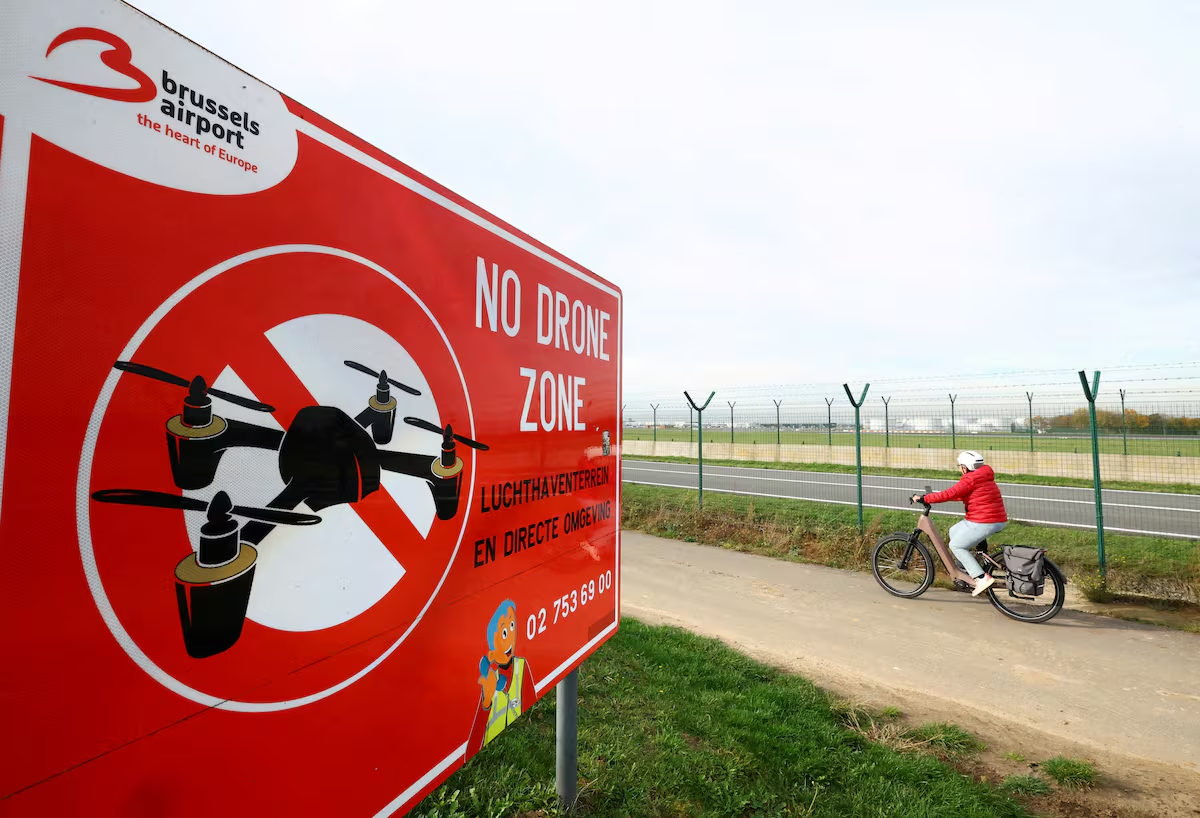
There is an almost comical scene that exemplifies the doctrine used by the Kremlin towards the West. It was last October 2nd. Russian journalist Fyodor Lukianov moderates the annual Valdai Discussion Club forum event in the spa city of Sochi. To his right sits Russian President Vladimir Putin. During the speech, Lukyanov sardonically asks him why he is sending drones to Denmark. He replies, “I won’t do it again.” It was a joke. Neither then nor now has the Kremlin taken responsibility for the unmanned planes that have flown without authorization in Europe over the past two months. An EU summit was being held on the same day in the Danish capital, Copenhagen, in the shadow of a September sighting of several unmanned planes that forced the closure of half a dozen airports and the cancellation of more than 100 flights. Then came Norway, Sweden, Germany, Belgium, Spain… Airports, military bases and nuclear power plants. European governments and militaries blame the Kremlin, despite there being no evidence of the accusation. Moscow is the only suspect.
And Arnold, an analyst at the British Royal United Services Institute (RUSI), explains it this way on the phone: “Russia does not need to have many drones in these places. It is enough to deploy one for a short period of time, or even the mere hint that there are drones in the air and that shows how vulnerable we are.”
It is enough to sow confusion through cognitive warfare, if it remains at a narrative level, or hybrid, if it combines conventional weapons (invasion of Ukraine or Russian fighter flights near NATO territory) with asymmetric ones such as sabotage (attacks on railways in Poland), threats to infrastructure (drones or balloons over airports and military bases) and propaganda campaigns.
In the case of unmanned aircraft over Europe – small in size, a far cry from the three-meter-tall devices used in Ukraine – the confusion is heightened thanks to the previous show of force carried out on September 10, with the launch of more than twenty Russian attack aircraft towards Poland. This was the momentum which allows us to understand the rest. Moscow demonstrated its capabilities, discovered the vulnerability of NATO neighbors and attacked the enemy’s psychology.
“Serious attack”
On the night between 22 and 23 September, 10 days after negotiations on the construction of a European anti-drone wall began in Brussels, Copenhagen airport suspended its activities due to the sighting of unmanned aircraft. Almost simultaneously, Gardermoen Airport in Oslo, the Norwegian capital, did the same after receiving information about the arrival of more planes. Danish Prime Minister Mette Frederiksen described it as “a serious attack on critical infrastructure in Denmark” and launched a state of alert: the sightings in Copenhagen were followed by Aalborg, Esbjerg, Sonderborg and Skrydstrup. Nearly two months later, none of the investigations conducted by Denmark or Norway have revealed details confirming that the drone threat was real.
But they were able to be spotted and not intercepted due to the lack of resources or regulations to control a growing phenomenon, thanks to the push of technology and progress in the Ukrainian theater of operations. As he recalls in a e-mail William Raillant-Clark, of the International Civil Aviation Organization, dependent on the UN, according to the Chicago Convention, no aircraft capable of flying without a pilot can do so on the territory of a State without authorization. This rule is of particular respect near strategic and sensitive places such as airports.
Dutchman Wiebe de Jager is one of Europe’s leading drone experts. “Many of the sightings appear to be misidentifications, from bright stars and distant aircraft lights, to police helicopters searching for the alleged drones,” he explains in an email. “In Germany there has also been a notable increase in reports (of sightings), although not to the same extent (as in Denmark and Norway). In the Netherlands, part of Schiphol Airport was briefly closed on 27 September; however, a subsequent investigation revealed that several pilots had mistaken a balloon for a drone,” he continues. This weekend it was the Dutch airport in Eindhoven, which also hosts a military air base, that had to divert traffic due to several drone alerts.
De Jager recalls other recent moments of “panic” regarding alleged drone flights that were not subsequently confirmed, such as at Gatwick airport (London) in December 2018, or in the North American state of New Jersey, in November last year.
In a recent conversation, a French military source confirmed both the real existence of unauthorized drones in European countries and that they pose a threat, whether flown by teenagers or by a resourceful actor. According to the same source, the “hybrid war” launched by Russia contributes to “manipulation and destabilization”. “The drone may be small,” continues the soldier, “but it creates great fear.” French security forces boarded the Russian cargo ship early last month Boracay in front of the port of Saint-Nazaire. It was believed that from this tanker Moscow was launching unmanned devices towards the continent. After a few days of investigations and with no conclusion in sight, the ship was able to continue its journey.
In addition to finding the culprits, the figures indicate a notable increase in these flights of unmanned devices. In October alone, the American conflict monitoring organization Acled counted around twenty unauthorized drones in seven European countries, sometimes in strategic locations such as three air bases in Germany and three military bases in Belgium; next to a Thales munitions factory, a key supplier to Ukraine, near the Belgian town of Herstal, or at the Reedo military barracks on Estonia’s eastern strip towards the Russian border.
This Thursday, the Euronews network, after analyzing data from 24 airports in 12 countries, revealed that from January 2024 to November this year, the number of business disruptions at European airports due to the presence of drones quadrupled. Belgium wins, with a dozen cases between the 2nd and 9th of this month. This is only in the civil section. The alarm in this country was raised when the sightings concentrated around the Kleine-Brogel air base, near the border with the Netherlands.
Belgium exemplifies two things. First, many European countries do not have defenses for this type of weapon. And, secondly, that when faced with a possible threat, even if not very concrete, if the Kremlin rings, we must react. The Belgian government asked allied countries for help. The UK has already deployed a British Air Force (RAF) unit there that specializes in intercepting unmanned aircraft. Speaking on the BBC, again amid confusion over the origin of the drones in Belgian skies, Air Marshal Sir Richard John Knighton said the most “plausible” thing was that the raids had been ordered from Moscow.
In this sense, Boris Pistorius, Defense Minister of Germany, a country that also responded to Belgium’s request for help, linked this escalation to the debate on the use of frozen Russian assets in a Brussels-based entity (185 billion euros). Arguments aside, Belgium followed suit and last week purchased a kamikaze defensive drone system from Latvia worth €50 million.
Faced with the threat in European airspace, NATO has deployed the American Merops anti-drone defense systems in the territory of Poland and Romania, the eastern flank of the Alliance. The goal is clear: to protect against unmanned attack aircraft from Russian launch batteries. Another thing that is different is the interception of lighter and more difficult to track devices. “Do we have the ability to safely shoot down drones over airports?” asks Ed Arnold of RUSI. “Yes, although it’s difficult. Do we have the ability to protect all the airports? No, not at all. That’s what the Russians think and that’s how they act right now.”
Putin’s speech in Sochi continued like this: “I will no longer send drones either to France or Denmark,” the Russian president clarified. “What other destinations can they reach?” he asked himself amidst laughter from the audience. “In Lisbon, and where else?” he continued. “Seriously, we don’t even have drones that can reach as far as Lisbon,” he added. Having said that, journalist Lukianov suggested that what happened in the Portuguese capital was perhaps a joke that someone could take seriously. “Why a joke? It’s not,” the Russian president responded. Once again, the confusion.





